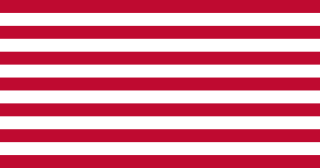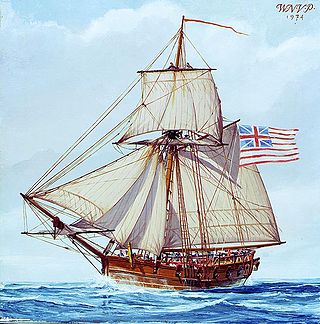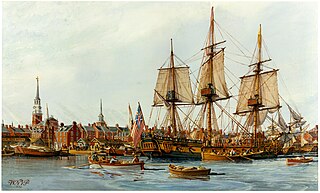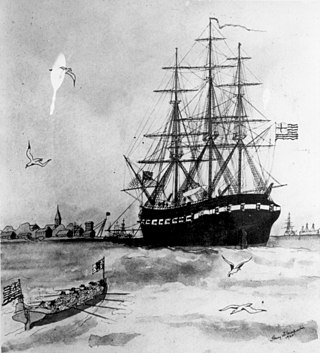Career
Hancock, was the former schooner Speedwell, hired from Mr. Thomas Grant of Marblehead, Massachusetts, in October 1775 as one of a small fleet fitting out to prey upon British supply ships and support General George Washington's siege of Boston, Massachusetts. This fleet, the first under Continental pay and control, came to be called "George Washington's Navy."
In October 1775, Hancock (not the Lynch [1] ), under the command of Nicholson Broughton, and Franklin were ordered to intercept two brigs as they arrived in the St. Lawrence River from England. But the two schooners instead sought easier quarry off Cape Canso where five prizes of dubious legality were taken. They also raided Charlottetown settlement without regard to orders to respect Canadian property. The story of their illegal actions reached General Washington who dismissed both ship commanders and returned their prizes to Nova Scotian owners with apologies.
On 1 January 1776, Captain John Manley, Continental Army, was appointed Commodore of the Fleet and hoisted his flag in Hancock. She captured two enemy transports on 25 January 1776, fending off an eight-gun British schooner in a brisk engagement while prize crews took the captured ships into Plymouth Harbor. [2]
On 30 January 1776 the 14-gun British Brig Hope, which had sailed from Boston for the express purpose of capturing Hancock, intercepted her off Plymouth. Manley ran Hancock ashore where it became impossible for Hope, with her deeper draft, to draw close aboard. The Americans later refloated Hancock and she later captured several more prizes in joint operations with the squadron by April 1776, when Captain Samuel Tucker relieved Commodore John Manley in command of Hancock. Manley was taken into the Continental Navy to command the Continental frigate Hancock.
The schooner Hancock captured two brigs off Boston 7 May 1776. She continued to cruise under Tucker until declared unfit for service late in 1776. She returned to her owner early the following year.

The first USS Columbus was a ship in the Continental Navy. Built as a merchant ship at Philadelphia in 1774 as Sally, she was purchased from Willing, Morris & Co., for the Continental Navy in November 1775, Captain Abraham Whipple was given command.

The Continental Navy was the navy of the Thirteen Colonies during the American Revolutionary War. Founded on October 13, 1775, the fleet developed into a relatively substantial force throughout the Revolutionary War, owing partially to the substantial efforts of the Continental Navy's patrons within the Continental Congress. These Congressional Patrons included the likes of John Adams, who served as the Chairman of the Naval Committee until 1776, when Commodore Esek Hopkins received instruction from the Continental Congress to assume command of the force.

The first USS Cabot of the United States was a 14-gun brig, one of the first ships of the Continental Navy, and the first to be captured in the American Revolutionary War in the Battle off Yarmouth (1777).

USS Providence was a sloop-of-war in the Continental Navy, originally chartered by the Rhode Island General Assembly as Katy. The ship took part in a number of campaigns during the first half of the American Revolutionary War before being destroyed by her own crew in 1779 to prevent her falling into the hands of the British after the failed Penobscot Expedition.

Alfred was the merchant vessel Black Prince, named for Edward, the Black Prince, and launched in 1774. The Continental Navy of what would become the United States Navy acquired her in 1775, renamed her Alfred after 9th century English monarch Alfred the Great, and commissioned her as a warship. She participated in two major actions, the battle of Nassau, and the action of 6 April 1776. The Royal Navy captured her in 1778, took her into service as HMS Alfred, and sold her in 1782. She then became the merchantman Alfred, and sailed between London and Jamaica.
The first USS Franklin was a schooner in the Continental Navy during the American Revolutionary War. She was named for Benjamin Franklin.

Samuel Tucker was an officer in the Continental Navy and the United States Navy.
The first USS Lee was a schooner under the Continental Army during the American Revolutionary War. She was named for General Charles Lee.

The second Hancock was one of the first 13 frigates of the Continental Navy. A resolution of the Continental Congress of British North America 13 December 1775 authorized her construction; she was named for the patriot and Continental congressman John Hancock. In her career she served under the American, British and French flags.

John Manley (c.1733–1793) was an officer in the Continental Navy and the United States Navy. Manley was appointed commodore of "George Washington's fleet."

The Pennsylvania Navy served as the naval force of Pennsylvania during the American Revolution and afterward, until the formation of the United States Navy. The navy's vessels served almost exclusively on the Delaware River, and were active in first defending the approaches to the city of Philadelphia during the British campaign that successfully occupied the city in 1777, and then preventing the Royal Navy from resupplying the occupying army.

HMS Lively was a 20-gun post ship of the Royal Navy, launched in 1756. During the Seven Years' War she captured several vessels, most notably the French corvette Valeur in 1760. She then served during the American Revolutionary War, where she helped initiate the Battle of Bunker Hill. The French captured her in 1778, but the British recaptured her in 1781. She was sold in 1784.

The schooner Hannah was the first armed American naval vessel of the American Revolution, authorized by the Continental Congress and operated by the Continental Army, and is considered by some the first vessel of the United States Navy. She was a fishing schooner owned by John Glover of Marblehead, Massachusetts and was named for his daughter, Hannah Glover. The crew was drawn largely from the town of Marblehead, with much of the ships ammunition being stored in Glover's warehouse now located at Glover's Square in Marblehead before being relocated to Beverly, Massachusetts.
USS Warren was one of the 13 frigates authorized by the Continental Congress on 13 December 1775. With half her main armament being 18-pounders, Warren was more heavily armed than a typical 32-gun frigate of the period. She was named for Joseph Warren on 6 June 1776. Warren was burned to prevent capture in the ill-fated Penobscot Expedition in 1779.
USS Lynch was a schooner acquired as part of the Continental Navy in 1776. She served for over a year on the New England coast, interfering with British maritime trade when possible. In 1777 she was assigned dispatch boat duty and, after delivering her secret dispatches to France, set sail for the United States with French secret dispatches. The British captured her, but not before she could destroy the French dispatches.

American colonial marines were various naval infantry units which served during the Revolutionary War on the Patriot side. After the conflict broke out in 1775, nine of the rebelling Thirteen Colonies established state navies to carry out naval operations. Accordingly, several marine units were raised to serve as an infantry component aboard the ships of these navies. The marines, along with the navies they served in, were intended initially as a stopgap measure to provide the Patriots with naval capabilities before the Continental Navy reached a significant level of strength. After its establishment, state navies, and the marines serving in them, participated in several operations alongside the Continental Navy and its marines.

The Battle of Block Island was a naval skirmish which took place in the waters off Rhode Island during the American Revolutionary War. The Continental Navy under the command of Commodore Esek Hopkins was returning from a successful raid on Nassau when it encountered HMS Glasgow, a Royal Navy dispatch boat.

The Battle off Halifax took place on 28 May 1782 during the American Revolutionary War. It involved the American privateer Jack and the 14-gun Royal Naval brig HMS Observer off Halifax, Nova Scotia. Captain David Ropes commanded Jack, and Lieutenant John Crymes commanded Observer. The battle was "a long and severe engagement" in which Captain David Ropes was killed.

HMS Surprise was a 28-gun Enterprise-class sixth-rate frigate of the Royal Navy, which served throughout the American Revolutionary War and was broken up in 1783.
HMS Diligent was a brig the Royal Navy purchased in 1777. The Continental Navy captured her in May 1779 and took her into service as the USS Diligent. She then participated in the disastrous Penobscot Expedition where her crew had to scuttle her in August to prevent her capture.













